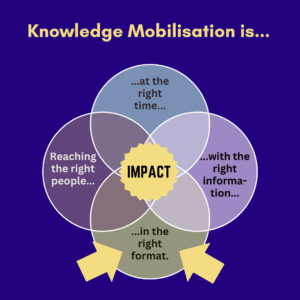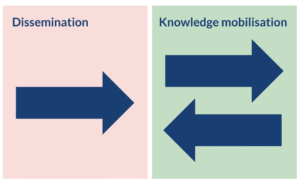In my last blog I outlined how to get the evaluation report right (and why that is important).
But… should a report always be the default? What other outputs are there, and how do you decide what outputs to create? Or going back to the “What is KM” diagram: How do you unpick the ‘right format’?

How to decide on evaluation outputs:
1. Work with evaluation commissioners and knowledge users
What output would be most useful to evaluation commissioners and wider evaluation use? The only way to find out is to ask – ideally early on, perhaps as part of the evaluability assessment and/or in specific knowledge mobilisation meetings.
You’ll need to ask the evaluation commissioners, but also other “knowledge users” (e.g. local residents, practitioners) – especially if you are looking to generate wider interest and impact.
To illustrate, we posed the question regarding output format to someone sitting in the chief executive office at a council we are working with. They came back with the following answer:
“It would be good to have a nitty gritty report – the finance guys will want to dig into it. It would also be good to have a summary slide deck, especially for elected members. This could show how it [the evaluation] plays into a broader vision”
2. Think about your wider knowledge mobilisation plans
As much as you try, you won’t be able to build relationships or co-produce knowledge mobilisation plans with all potential knowledge users. This makes it even more important to help people engage with your research by creating multiple entry points. This has been termed ‘the Wedding Cake approach’ (read more in this blog by Rob Davies):
😋 Taste: Social media posts and infographics for quick consumption.
🍰 Snack: Briefing notes and blogs for deeper engagement.
🎂 Feast: Research papers and datasets for comprehensive analysis.
So, when thinking about your wider knowledge mobilisation plan – have a spread of outputs on hand. That way, you could engage Council X with an evaluation done in Council Y by sending them a one-page infographic or fact sheet, which could generate interest and link the full report.
Examples of evaluation outputs (not reports!)
The great thing about the NIHR PHIRST website is that it is not just a repository of public health evaluations, it is also a repository of diverse knowledge mobilisation outputs. Below is a spread of possible outputs as seen across PHIRST evaluations (it’s not an exhaustive list, but perhaps good for inspiration?).
Some things to bear in mind when creating an alternative output:
- Can you co-produce any of these outputs with the target audience (e.g. council staff or members of the public)?
- Do you have a way to link to further information about the evaluation (e.g. a QR code)?
- Is there anything you could do to help track how a particular output is used (e.g. a DOI or ‘how to cite this’ instructions)?
- Do you have the skills in house, or do you work with a partner to create a specific output (e.g. animations)?
Think beyond one-way dissemination
Dissemination is one part of knowledge mobilisation, but on its own it is limited in scope and success.

Here’s some ways to avoid a one-way “push” of information, and encourage the “two-way” creation and sharing of knowledge:1. Go back to the KM diagram: apart from the format, it is also about the right time, the right information (e.g. key message/framing of message) and the right audience.2. Ask lots of questions and co-produce where possible. This can start early with the 3 questions, the evaluability assessment or dedicated knowledge mobilisation meetings.3. Think about other outputs: the table above shows discreet “knowledge mobilisation products”. But there are also other, less tangible, KM outputs. For instance, delivering workshops at conferences, developing training/toolkits or establishing new communities of practice. Or think about more interactive outputs. For example, I recently came across these two:
- An interactive evidence map on housing and public health: KNOW-PH Evidence Map – KNOW-PH version | Genially
- A virtual exhibition on Gendered Environments of Sports Injury: More Than Medals – Gendered Environments in Sport
4. Above all: aim to move from passive consumption of knowledge to active engagement with knowledge. How can you prompt or provoke a “lightbulb” moment? How can you help knowledge users interact with evidence and find direct applications to their policy and practice? This deserves a whole other blog post. Co-production and relationship building will help, as will action learning sets or simple techniques like asking people to send in questions in advance of a webinar.


